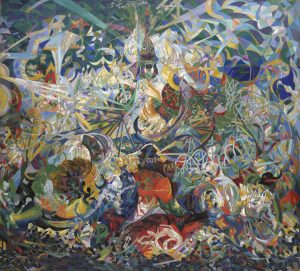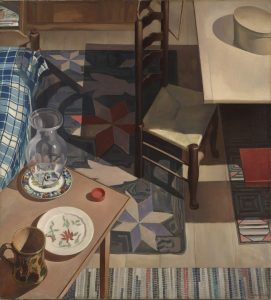Table of Contents
LESSON 11 – European modernism / American modernity
WHAT TO READ, WATCH, OR LISTEN TO BEFORE CLASS.
From your textbook, American Encounters:
- From Chapter 12, review “Stieglitz and His Circle,” pages 404-413. Focus on Arthur Dove and Georgia O’Keeffe. These two artists appear briefly at about 5:55 in the video “A Case for Abstraction”, above.
- In Chapter 13, read the intro, pages 421-22. Focus on European modernism (in art) and American modernity (in machines, pop culture, and architecture). Review definitions of modernism and modernity on page 392.
- Browse pages 422-444. Focus on Duchamp, Nude Descending a Staircase, 1912; New York Dada; Picabia, Ici, Cést Ici Stieglitz Foi et Amour, 1915; Readymade; Man Ray’s portrait of Duchamp as Rrose Sélavy, 1924; Alexander Calder’s Circus, 1926-31; Marsden Hartley, Portrait of a German Officer, 1914 (p. 420); and Charles Demuth, I Saw the Figure 5 in Gold, 1928 (pages 388, 468-469).
- Read “The Early Career of Frank Lloyd Wright,” pages 445-447. This house is related to the Robie house in Chicago, which is better known.
- In Chapter 14, browse pages 451-467. Focus on the Chrysler Building and Art Deco; Max Weber’s Rush Hour, NYC, 1915; and Joseph Stella’s Battle of Lights, Coney Island, 1913.

From the Metropolitan Museum of Art:
- Slide show, “Alfred Stieglitz (1864-1946) and His Circle.”
- Slide show, “Walker Evans (1903-1975).”
- Slide show, “Precisionism.”
From Seeing America by Smarthistory:
- In-depth looks at Duchamp, Picabia, Hartley, and Demuth. Focus on the modernist portraits of Stieglitz, the German officer, and the poet William Carlos Williams.
- An in-depth look at Frank Lloyd Wright’s Fallingwater, 1935-38, including the earlier Robie House, 1908-10.
- An in-depth look at the Chrysler Building, 1927-30. Architects had more than one way to be “modern.”
WHAT TO SEE, SKIM, OR SAMPLE AS TIME ALLOWS.
Wikipedia has a good presentation of New York skyscrapers by Georgia O’Keeffe from the boom years of the 1920s, when the NYC skyline was a rapidly changing, uniquely American spectacle. O’Keeffe moved to New Mexico in 1929; the giddy real estate market ended with the October crash.
A recent example of unconventional portraiture:
Picabia, /Man Ray/Duchamp, Marsden Hartley, and Charles Demuth all presented us with portraits that challenged our expectations in this lesson. In 2018, the Smithsonian’s National Portrait Gallery installed two portraits that also challenged expectations.
Kehinde Wiley, Barack Obama portrait. Amy Sherald, Michelle Obama portrait.
LESSON 12 – Harlem, Mexico, and the importance of “place.”
WHAT TO READ, WATCH, OR LISTEN TO BEFORE CLASS.
From your textbook, American Encounters:
- In Chapter 14, read “The Human City: Spectacle, Memory, Desire,” pages 474-483. Focus on Isabel Bishop, Archibald Motley, and Edward Hopper.
- In Chapter 15, “Searching for Roots,” read 485-487. Focus on “The Usable Past” and work by Charles Sheeler. Browse the following section on Regionalism, which embraced rural subjects and rejected abstraction. This section looks at American art in the context of economic crisis and global politics. Art from the 1930s is still interpreted in light of the rise of fascism and the approach of World War II.

- Read about the revival of the Santero tradition in the American southwest, pp. 503-504.
- Read “The ‘New Negro’ Movement and Versions of a Black Art,” pp. 507-515. All of these artists are important. Consider why some are called “folk” and others “vernacular.” Why is Archibald Motley not in either group?
- In Chapter 16, “Depression Years,” read the introduction and browse the section about Mexican muralists and printmakers, pp. 517-525; note the concerns of artists Charles White, Ben Shahn, and Philip Evergood.
- Under “Epics of Migration,” pages 526-529, focus on Jacob Lawrence and Aaron Douglas.
Related works:
- Thomas Hart Benton’s 1930-31 mural project, America Today. Entire mural has been re-installed in a room at the Metropolitan Museum of Art.
- Printmaking from the Taller de Gráfica Popular, at the Los Angeles County Museum of Art.
- The complete Migration Series by Jacob Lawrence from the Phillips Collection in Washington, DC. Includes audio and a video of the artist.
More from the history of Harlem:
Jazz pianist James P. Johnson, 1930: You’ve Got to Be Modernistic.
James Van Der Zee, Couple, Harlem, 1932. Van Der Zee had a photography studio in Harlem and left an archive of group and family portraits.
Club Julio A. Mella, 1937, by New York painter Henry Glintenkamp, shows a worker’s club in Harlem that was a center for writers, artists, and anti-fascist activists during the 1930s. A better look at the painting in the American collection at the Chrysler Museum of Art in Norfolk, Virginia.
From Seeing America by Smarthistory:
- Video (8 min.): Aaron Douglas, Aspiration, 1936. Murals at the Texas Centennial Exposition. There are also seven full-page Aaron Douglas illustrations in James Weldon Johnson’s God’s Trombones: Seven Negro Sermons in Verse, 1927.
- Video (7 min.): “Harlem 1948, Ralph Ellison, Gordon Parks, and the Photo Essay” featuring photograph by Gordon Parks, Off on my Own, 1948.
- Video (6 min.): Nampeyo. (Hopi-Tewa culture.) Polychrome Pot, 1934. This pot is in the National Museum of the American Indian NYC.
WHAT TO SEE, SKIM, OR SAMPLE AS TIME ALLOWS.
Revolutionary African-American artists from Alabama, continuing their work today:
Sculptor Lonnie Holley (p. 514 in American Encounters) and Gee’s Bend quilter Loretta Pettway and their colleagues at the Souls Grown Deep Foundation.
LESSON 13 – Abstraction, Pop Art, and Postmodernism
WHAT TO READ, WATCH, OR LISTEN TO BEFORE CLASS.
From your textbook, American Encounters:
- In Chapter 17, “Consensus and Anxiety 1945-1960,” read the introduction, page 551. Focus on the image of the postwar artist in the last paragraph. Browse “The Origins of Abstract Expressionism,” pages 555-566. Focus on Jackson Pollock, Guardians of the Secret, 1943; Mark Rothko, No. 61, 1963; and Willem de Kooning, Woman I, 1950-52.
- In “Beyond Abstract Expressionism,” pages 566-570, focus on Jasper Johns, Flag, 1954-55; Robert Rauschenberg, Bed, 1955; and Joseph Albers, Homage to the Square, 1959.
- In Chapter 18, “Art into Life, 1960-1980,” read the introduction, page 589, and focus on the terms performance, pop, and minimalism. Browse pages 590-602 for examples. Focus on Andy Warhol, pages 594 -596. Compare the Condensation Cube by Hans Haacke on page 614 to Robert Smithson’s Spiral Jetty, page 616.
- In Chapter 19, “American Art in Flux, 1980 – present,” read the introduction, page 623. Focus on the terms postmodernism and globalization.
- Read about Cindy Sherman’s Untitled Film Stills, 1978, in “The Death of the Artist” and focus on the terms intertextual, intentionality, and appropriation, pp. 624-625. Compare Sherman’s “film still” to Reginald Marsh’s Twenty Cent Movie, 1936, p. 475.
- Compare Jaune Quick-to-See Smith’s Trade on page 635 with Rauschenberg’s Bed on page 569.
From Seeing America by Smarthistory:
- Video (6 min.): “Icon and Irony: Jasper Johns’s Flag.” 1954-55.
- Video (4 min.): “The Case for Andy Warhol.”
- Video (6 min.): Benny Andrews, Flag, 1966. “Identity and Civil Rights in 1960s America.” This could be part of the “Figures of Resistance” section on pp. 610-611 in your textbook. See also Benny Andrews, Intruder, 1964, from Google Arts and Culture. In the 1980s, Robert Colescott’s paintings were more successful.
- Video (6 min.): “Making an Icon: JFK and the Power of Media,” Garry Winogrand, Democratic National Convention, Los Angeles, 1960. Gelatin silver print (photograph). For more photography of this period, see pp. 574-575 in your textbook, especially Diane Arbus and Robert Frank.
- An in-depth look at Jaune Quick-to-See Smith’s Trade, 1992: “That’s the deal you gave us.”
- An in-depth look at art and modern media: “Television Nation: Nam June Paik’s Electronic Superhighway,” 1995.
WHAT TO SEE, SKIM, OR SAMPLE AS TIME ALLOWS.
The online version of a recent blockbuster at the Metropolitan Museum of Art:
Kerry James Marshall: Mastry. And an article in the New York Times by Holland Cotter about that exhibition.
And a final quizzical look at the making of one man’s American identity:
Article and photo essay from The New Yorker‘s Photo Booth:
Tseng Kwong Chi, an “Ambiguous Ambassador” to Life in America.



